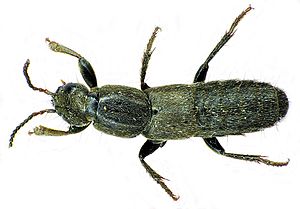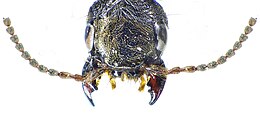Ocypus aeneocephalus
| Ocypus aeneocephalus | ||||||||||||
|---|---|---|---|---|---|---|---|---|---|---|---|---|

Ocypus aeneocephalus |
||||||||||||
| Systematics | ||||||||||||
|
||||||||||||
| Scientific name | ||||||||||||
| Ocypus aeneocephalus | ||||||||||||
| ( De Geer , 1774) |
Ocypus aeneocephalus is a beetle from the large family of the short-winged birds and the subfamily Staphylininae . The genus Ocypus is divided into several subgenera, the species Ocypus aeneocephalus belongs to the subgenus Pseudocypus , which is represented in Europe with 19 species.
The generic name Ocypus from ancient Greek οκύπους 'okýpous' means 'fast-footed'. The species name aeneocephalus (from Latin 'aëneus', ore-colored' and ancient Greek κεφαλή, 'kephalē', 'head') alludes to the ore shimmer of the head.

|

|
| Fig. 1: Head from above |
Fig. 2: Head from the bottom right partially colored green: lip button red: jaw button blue: upper jaw yellow: lower jaw |
| Fig. 3: Puncture on the side of the pronotum |
features
The very hairy beetle becomes eleven to fifteen millimeters long, the body is black with a bronze shimmer, antenna tarsi and front rails are more or less reddish brown.
The almost circular head has an offset neck. The head is somewhat narrower than the pronotum and shows the typical characteristics of the subfamily: the antennae are deflected at the front edge of the head and the distance between the deflection points is greater than the distance to the front edge of the eyes but smaller than the distance between the bases of the upper jaws ( Fig. 1). The temples are shorter than the longitudinal diameter of the eyes. The end segment of the jaw probe (Fig. 2, right red) is bare and elongated spindle-shaped, the end segment of the lip probe (Figure 2 right green) is only slightly thicker, elongated oval. The end links of both buttons are narrowly truncated at the tip. The upper jaws are wide and stocky with a distinct central tooth and additional teeth on the inside. The hollow on the underside of the jaw behind the middle tooth (prostheka) has long eyelashes (Fig. 2, naturally yellow). The eleven-part antennae are cord-shaped and hardly broaden outwards (Fig. 1).
The pronotum is longer than it is wide, cut straight at the front when viewed from above and convexly curved at the back. Next to the smooth midline of the pronotum there is a clear row of dots, to the side of which the pronotum is dense and uniformly dotted (Fig. 3). The hair on the outer half of the pronotum is not directed inwards, but backwards and sometimes slightly outwards. On the inner half, the hair on both sides of the center line is arranged in a strip in which the hair diverges towards the back on both sides (taxo picture).
The elytra are shortened, significantly shorter than the pronotum and hardly wider than this. Their sides are parallel. The label has a conspicuous black spot that is created by dark tomentation .
The process of the middle breast, which is pushed between the middle hips, ends in a point.
The abdomen is about the same width as the elytra. It is stiffly hairy on the upper side, lying on the back, the hairiness forms alternating lighter and darker stripes, which are differently developed depending on the area of distribution.
biology
Larva and imago are predatory. They can be found in the ground chaff, under stones and moss in various habitats, both on the plains and in the mountains. In the case of catches with floor traps, in which nine different areas (arable land, various meadows, hedge areas and forest) were compared, it was found that Ocypus aeneocephalus clearly preferred the natural meadows, and of these less clearly the more humid ones. In the Netherlands the species was caught in the heather from September to May, most commonly from October to December. In Rhineland-Palatinate , one specimen was caught on an extensively used oat meadow and one on bushy, semi-dry grassland, also in autumn. However, the species shows a preference for moist grassland.
Doll
The front edge of the pronotum is provided with 27 hair-like processes, the side edge of the abdomen has two pairs of hair-like processes on each side.
distribution
The species is distributed in the Holarctic , but there are no reports from Portugal , Belarus , most of the Mediterranean islands and the countries of Southeastern Europe. In other countries ( Ireland , various European parts of Russia ) the occurrence is doubtful. In Central Europe the species is rather rare, on a red list of Berlin it is listed as very rare and threatened with extinction.
literature
- Heinz Joy, Karl Wilhelm Harde, Gustav Adolf Lohse: The beetles of Central Europe. Volume 4 Staphylinidae I Goecke & Evers Verlag, Krefeld 1964
- Edmund Reitter : Fauna Germanica, the beetles of the German Empire, Volume II, KGLutz 'Verlag, Stuttgart 1909
Individual evidence
- ↑ a b Ocypus aeneocephalus in Fauna Europaea. Retrieved March 7, 2012
- ↑ Pseudocypus (subgenus) in Fauna Europaea. Retrieved March 7, 2012
- ↑ Sigmund Schenkling: Explanation of the scientific beetle names.
- ↑ a b Aleš Smetana , Anthony Davis: "Reclassification of the North Temperate Taxa Asociated with Staphylinus Sensu Lato Including Comments on Relevant Subtribes of Staphylinini (Coleoptera, Styphylinidae)" American Museum Novitates, Number 3287: 1-88. 2000, doi : 10.1206 / 0003-0082 (2000) 287 <0001: ROTNTT> 2.0.CO; 2
- ↑ Konrad THALER, Alois KOFLER & Erwin MEYER: Fragmenta Faunistica Tirolensia - IX Ber. nat.-med. Innsbruck Association Volume 77 pp. 225–243, Innsbruck, Oct. 1990 as PDF
- ↑ FCF Sterrenburg: Supplements to the staphylinid fauna of the Netherlands 2 (Coleoptera: Staphylinidae) Nederlandse Faunistische Mededelingen, 7: 27-30 as PDF
- ↑ Edmund Wenzel, Karsten Hannig: Remarkable beetle evidence on the Heimberg near Schloßböckelheim on the Middle Nahe (Ins., Coleoptera) Coleo 3 p. 69–114, 2001 ISSN 1616-329X downloadable
- ↑ Sonja Hennicke, b. Medel: The ecological characterization of the epigean short-winged community (Coleoptera, Staphylinidae) of the coastal floodplain of the Greifswald Bodden Inaugural dissertation at the Ernst-Moritz-Arndt University Greifswald December 2007 as PDF
- ↑ Polish koleopterologische page
- ↑ Melania Stan: "On the species of Ocypus Leach. On the Carpathian Basin with special reference to the species of Romania (Coleoptera: Staphylinidae: Staphylininae: Staphylinini)" Acta entomologica serbica, 2010, 15 (2): 171-193 UDC 595.763 (498) as PDF
- ↑ Bernard Staniec: "Description of the pupae of Philonthus corvinus ERICHSON, 1839, Ph. Micans (GRAVENHORST, 1802), and Ph. Punctus (GRAVENHORST, 1802) (Coleoptera: Staphylinidae)" Genus, Vol.14 (1): 15 -26 Breslau April 15, 2003 Determination table for the pupae of some short-winged birds ( memento of the original from January 1, 2016 in the Internet Archive ) Info: The archive link was automatically inserted and not yet checked. Please check the original and archive link according to the instructions and then remove this notice. (PDF; 266 kB)
- ↑ Horst Korge: Red list and list of total species of the raven beetles (Coleoptera: Staphylinidae) in Berlin as PDF ( memento of the original from April 13, 2016 in the Internet Archive ) Info: The archive link was inserted automatically and has not yet been checked. Please check the original and archive link according to the instructions and then remove this notice.
